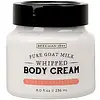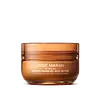What's inside
What's inside
 Key Ingredients
Key Ingredients

 Benefits
Benefits

 Concerns
Concerns

 Ingredients Side-by-side
Ingredients Side-by-side

Water
Skin ConditioningGlycerin
HumectantCocos Nucifera Oil
MaskingElaeis Guineensis Oil
EmollientEthylhexyl Palmitate
EmollientStearic Acid
CleansingStearyl Alcohol
EmollientParfum
MaskingDimethicone
EmollientSodium Stearate
CleansingMangifera Indica Seed Butter
Skin ConditioningTheobroma Cacao Seed Butter
EmollientPersea Gratissima Oil
Skin ConditioningButyrospermum Parkii Butter
Skin ConditioningArgania Spinosa Kernel Oil
EmollientRosa Canina Seed Oil
EmollientAloe Barbadensis Leaf Juice
Skin ConditioningCaprae Lac
Skin ConditioningCamellia Sinensis Leaf Extract
AntimicrobialVitis Vinifera Seed Extract
AntimicrobialVaccinium Myrtillus Bud Extract
AntioxidantSilybum Marianum Extract
Skin ConditioningPinus Pinaster Bark Extract
AntioxidantGinkgo Biloba Leaf Extract
Skin ConditioningTocopherol
AntioxidantAscorbyl Palmitate
AntioxidantAcrylates/C10-30 Alkyl Acrylate Crosspolymer
Emulsion StabilisingEthylhexylglycerin
Skin ConditioningPhenoxyethanol
PreservativeXanthan Gum
EmulsifyingSteareth-21
CleansingTetrasodium EDTA
Water, Glycerin, Cocos Nucifera Oil, Elaeis Guineensis Oil, Ethylhexyl Palmitate, Stearic Acid, Stearyl Alcohol, Parfum, Dimethicone, Sodium Stearate, Mangifera Indica Seed Butter, Theobroma Cacao Seed Butter, Persea Gratissima Oil, Butyrospermum Parkii Butter, Argania Spinosa Kernel Oil, Rosa Canina Seed Oil, Aloe Barbadensis Leaf Juice, Caprae Lac, Camellia Sinensis Leaf Extract, Vitis Vinifera Seed Extract, Vaccinium Myrtillus Bud Extract, Silybum Marianum Extract, Pinus Pinaster Bark Extract, Ginkgo Biloba Leaf Extract, Tocopherol, Ascorbyl Palmitate, Acrylates/C10-30 Alkyl Acrylate Crosspolymer, Ethylhexylglycerin, Phenoxyethanol, Xanthan Gum, Steareth-21, Tetrasodium EDTA
Water
Skin ConditioningArgania Spinosa Kernel Oil
EmollientCaprylic/Capric Triglyceride
MaskingHelianthus Annuus Seed Oil
EmollientGlyceryl Stearate
EmollientGlycerin
HumectantButyrospermum Parkii Butter
Skin ConditioningHydroxyethyl Acrylate/Sodium Acryloyldimethyl Taurate Copolymer
Emulsion StabilisingSqualane
EmollientCetearyl Glucoside
EmulsifyingCoco-Caprylate/Caprate
EmollientPolysorbate 60
EmulsifyingParfum
MaskingTocopherol
AntioxidantAloe Barbadensis Leaf Juice
Skin ConditioningPhenoxyethanol
PreservativeCetearyl Alcohol
EmollientPersea Gratissima Oil
Skin ConditioningAllantoin
Skin ConditioningCamellia Sinensis Leaf Extract
AntimicrobialSymphytum Officinale Leaf Extract
Skin ConditioningEthylhexylglycerin
Skin ConditioningPanthenol
Skin ConditioningHelianthus Annuus Flower Extract
Skin ConditioningAmyl Acetate
MaskingEthyl Butyrate
PerfumingHexyl Acetate
MaskingBeta-Carotene
Skin ConditioningWater, Argania Spinosa Kernel Oil, Caprylic/Capric Triglyceride, Helianthus Annuus Seed Oil, Glyceryl Stearate, Glycerin, Butyrospermum Parkii Butter, Hydroxyethyl Acrylate/Sodium Acryloyldimethyl Taurate Copolymer, Squalane, Cetearyl Glucoside, Coco-Caprylate/Caprate, Polysorbate 60, Parfum, Tocopherol, Aloe Barbadensis Leaf Juice, Phenoxyethanol, Cetearyl Alcohol, Persea Gratissima Oil, Allantoin, Camellia Sinensis Leaf Extract, Symphytum Officinale Leaf Extract, Ethylhexylglycerin, Panthenol, Helianthus Annuus Flower Extract, Amyl Acetate, Ethyl Butyrate, Hexyl Acetate, Beta-Carotene
Ingredients Explained
These ingredients are found in both products.
Ingredients higher up in an ingredient list are typically present in a larger amount.
Aloe Barbadensis Leaf Juice comes from leaves of the aloe plant. Aloe Barbadensis Leaf Juice is best known for helping to soothe sunburns. It is also anti-inflammatory, moisturizing, antiseptic, and can help heal wounds.
Aloe is packed with good stuff including Vitamins A, C, and E. These vitamins are antioxidants, which help fight free-radicals and the damage they may cause. Free-radicals are molecules that may damage your skin cells, such as pollution.
Aloe Barbadensis Leaf Juice also contains sugars. These sugars come in the form of monosaccharides and polysaccharides, folic acid, and choline. These sugars are able to help bind moisture to skin.
It also contains minerals such as calcium, 12 anthraquinones, fatty acids, amino acids, and Vitamin B12.
Learn more about Aloe Barbadensis Leaf JuiceYou may know this ingredient as argan oil. Argan Oil has antioxidant, hydrating, and soothing properties.
Studies have shown argan oil can help fight again radical damage from the sun. This makes it effective at preventing hyperpigmentation.
Large amounts of vitamin E found in argan oil helps the skin retain water. Argan oil also contains fatty acids such as linoleic acid, oleic acid, and palmitic acid. It is also a good source of lipids.
Another benefit of argan oil is skin-soothing. It can help reduce inflammation-related skin symptoms.
Argan Oil is effective at regulating sebum production in pores. This can make it effective at treating hormonal acne.
Traditionally, argan oil was used for its antibacterial and antifungal properties. However, argan oil contains fatty acids that may make it not fungal-acne safe.
Argan Trees are native to Morocco.
Learn more about Argania Spinosa Kernel OilThis ingredient is also known as shea butter. It is an effective skin hydrator and emollient.
Emollients help soothe and soften your skin. It does this by creating a protective film on your skin. This barrier helps trap moisture and keeps your skin hydrated. Emollients may be effective at treating dry or itchy skin.
Shea butter is rich in antioxidants. Antioxidants help fight free-radicals, or molecules that may harm the body. It is also full of fatty acids including stearic acid and linoleic acid. These acids help replenish the skin and keep skin moisturized.
While Shea Butter has an SPF rating of about 3-4, it is not a sunscreen replacement.
Shea butter may not be fungal acne safe. We recommend speaking with a professional if you have any concerns.
Learn more about Butyrospermum Parkii ButterCamellia Sinensis Leaf Extract is derived from the leaves of the tea plant. Black tea, green tea, and oolong tea are all harvested from this plant.
This ingredient has many skin benefits:
This ingredient contains polyphenols, a strong antioxidant. Antioxidants help fight off molecules that damage skin cells.
On top of that, the antioxidants in green tea neutralize free-radicals from the sun. This gives the skin some extra UV protection, but should not replace sunscreen.
Many components of tea have anti-inflammatory properties.
Polyphenols and L-theanine help soothe the skin and reduce irritation. The caffeine in Camellia Sinensis Leaf Extract helps calm inflamed blood vessels.
Other compounds found in tea include: Vitamin Bs, linoleic acid, magnesium, calcium, iron, and zinc.
Research has shown both drinking Camellia Sinensis Leaf Tea and applying it to the skin can help boost skin elasticity and hydration. Studies also show using tea extract may reduce sebum, or oil, production.
Learn more about Camellia Sinensis Leaf ExtractEthylhexylglycerin (we can't pronounce this either) is commonly used as a preservative and skin softener. It is derived from glyceryl.
You might see Ethylhexylglycerin often paired with other preservatives such as phenoxyethanol. Ethylhexylglycerin has been found to increase the effectiveness of these other preservatives.
Glycerin is already naturally found in your skin. It helps moisturize and protect your skin.
A study from 2016 found glycerin to be more effective as a humectant than AHAs and hyaluronic acid.
As a humectant, it helps the skin stay hydrated by pulling moisture to your skin. The low molecular weight of glycerin allows it to pull moisture into the deeper layers of your skin.
Hydrated skin improves your skin barrier; Your skin barrier helps protect against irritants and bacteria.
Glycerin has also been found to have antimicrobial and antiviral properties. Due to these properties, glycerin is often used in wound and burn treatments.
In cosmetics, glycerin is usually derived from plants such as soybean or palm. However, it can also be sourced from animals, such as tallow or animal fat.
This ingredient is organic, colorless, odorless, and non-toxic.
Glycerin is the name for this ingredient in American English. British English uses Glycerol/Glycerine.
Learn more about GlycerinParfum is a catch-all term for an ingredient or more that is used to give a scent to products.
Also called "fragrance", this ingredient can be a blend of hundreds of chemicals or plant oils. This means every product with "fragrance" or "parfum" in the ingredients list is a different mixture.
For instance, Habanolide is a proprietary trade name for a specific aroma chemical. When used as a fragrance ingredient in cosmetics, most aroma chemicals fall under the broad labeling category of “FRAGRANCE” or “PARFUM” according to EU and US regulations.
The term 'parfum' or 'fragrance' is not regulated in many countries. In many cases, it is up to the brand to define this term.
For instance, many brands choose to label themselves as "fragrance-free" because they are not using synthetic fragrances. However, their products may still contain ingredients such as essential oils that are considered a fragrance by INCI standards.
One example is Calendula flower extract. Calendula is an essential oil that still imparts a scent or 'fragrance'.
Depending on the blend, the ingredients in the mixture can cause allergies and sensitivities on the skin. Some ingredients that are known EU allergens include linalool and citronellol.
Parfum can also be used to mask or cover an unpleasant scent.
The bottom line is: not all fragrances/parfum/ingredients are created equally. If you are worried about fragrances, we recommend taking a closer look at an ingredient. And of course, we always recommend speaking with a professional.
Learn more about ParfumPersea Gratissima Oil is also known as avocado oil.
Avocado Oil has antioxidant properties. It is mostly made up of the glycerides of fatty acids. About 67% of these fatty acids is made up of oleic acid. Palmitic acid and linoleic acid are also present.
These fatty acids help hydrate and soften the skin. It may increase collagen content in the skin. Collagen helps keep your skin plump and firm. This ingredient helps reduce inflammation and has not shown to clog pores.
This ingredient may not be fungal-acne safe due to its high fatty acid content.
Avocados also have B vitamins, vitamin K, vitamin C, vitamin E, and potassium.
Learn more about Persea Gratissima OilPhenoxyethanol is a preservative that has germicide, antimicrobial, and aromatic properties. Studies show that phenoxyethanol can prevent microbial growth. By itself, it has a scent that is similar to that of a rose.
It's often used in formulations along with Caprylyl Glycol to preserve the shelf life of products.
Tocopherol (also known as Vitamin E) is a common antioxidant used to help protect the skin from free-radicals and strengthen the skin barrier. It's also fat soluble - this means our skin is great at absorbing it.
Vitamin E also helps keep your natural skin lipids healthy. Your lipid skin barrier naturally consists of lipids, ceramides, and fatty acids. Vitamin E offers extra protection for your skin’s lipid barrier, keeping your skin healthy and nourished.
Another benefit is a bit of UV protection. Vitamin E helps reduce the damage caused by UVB rays. (It should not replace your sunscreen). Combining it with Vitamin C can decrease sunburned cells and hyperpigmentation after UV exposure.
You might have noticed Vitamin E + C often paired together. This is because it is great at stabilizing Vitamin C. Using the two together helps increase the effectiveness of both ingredients.
There are often claims that Vitamin E can reduce/prevent scarring, but these claims haven't been confirmed by scientific research.
Learn more about TocopherolWater. It's the most common cosmetic ingredient of all. You'll usually see it at the top of ingredient lists, meaning that it makes up the largest part of the product.
So why is it so popular? Water most often acts as a solvent - this means that it helps dissolve other ingredients into the formulation.
You'll also recognize water as that liquid we all need to stay alive. If you see this, drink a glass of water. Stay hydrated!
Learn more about Water